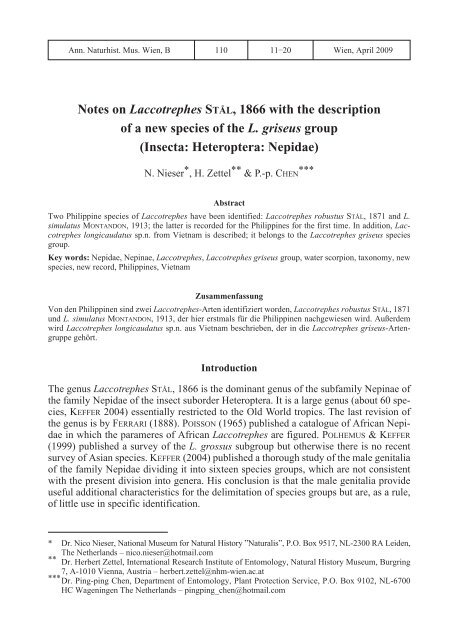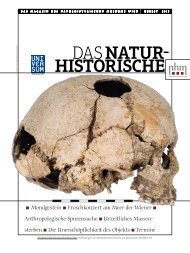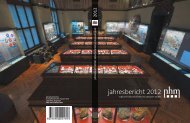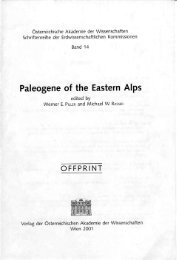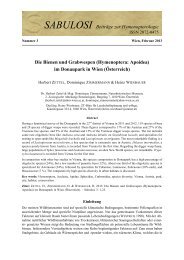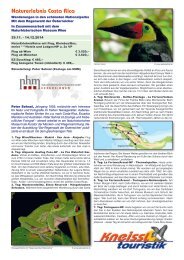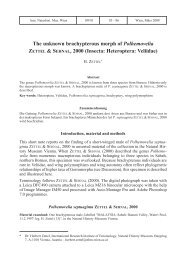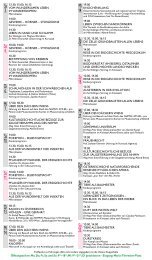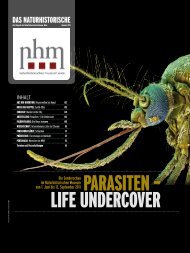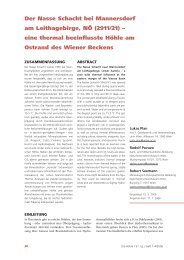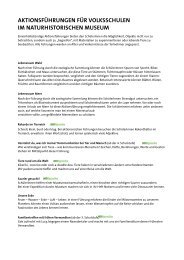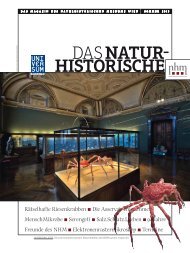Notes on Laccotrephes STÅL, 1866 with the description of a new ...
Notes on Laccotrephes STÅL, 1866 with the description of a new ...
Notes on Laccotrephes STÅL, 1866 with the description of a new ...
Create successful ePaper yourself
Turn your PDF publications into a flip-book with our unique Google optimized e-Paper software.
nieser&zettel&chen:krendl.qxd 11.03.2009 14:36 Seite 11<br />
Ann. Naturhist. Mus. Wien, B 110 11–20 Wien, April 2009<br />
<str<strong>on</strong>g>Notes</str<strong>on</strong>g> <strong>on</strong> <strong>Laccotrephes</strong> <strong>STÅL</strong>, <strong>1866</strong> <strong>with</strong> <strong>the</strong> descripti<strong>on</strong><br />
<strong>of</strong> a <strong>new</strong> species <strong>of</strong> <strong>the</strong> L. griseus group<br />
(Insecta: Heteroptera: Nepidae)<br />
N. Nieser * , H. Zettel ** & P.-p. CHEN ***<br />
Abstract<br />
Two Philippine species <strong>of</strong> <strong>Laccotrephes</strong> have been identified: <strong>Laccotrephes</strong> robustus <strong>STÅL</strong>, 1871 and L.<br />
simulatus MONTANDON, 1913; <strong>the</strong> latter is recorded for <strong>the</strong> Philippines for <strong>the</strong> first time. In additi<strong>on</strong>, <strong>Laccotrephes</strong><br />
l<strong>on</strong>gicaudatus sp.n. from Vietnam is described; it bel<strong>on</strong>gs to <strong>the</strong> <strong>Laccotrephes</strong> griseus species<br />
group.<br />
Key words: Nepidae, Nepinae, <strong>Laccotrephes</strong>, <strong>Laccotrephes</strong> griseus group, water scorpi<strong>on</strong>, tax<strong>on</strong>omy, <strong>new</strong><br />
species, <strong>new</strong> record, Philippines, Vietnam<br />
Zusammenfassung<br />
V<strong>on</strong> den Philippinen sind zwei <strong>Laccotrephes</strong>-Arten identifiziert worden, <strong>Laccotrephes</strong> robustus <strong>STÅL</strong>, 1871<br />
und L. simulatus MONTANDON, 1913, der hier erstmals für die Philippinen nachgewiesen wird. Außerdem<br />
wird <strong>Laccotrephes</strong> l<strong>on</strong>gicaudatus sp.n. aus Vietnam beschrieben, der in die <strong>Laccotrephes</strong> griseus-Artengruppe<br />
gehört.<br />
Introducti<strong>on</strong><br />
The genus <strong>Laccotrephes</strong> <strong>STÅL</strong>, <strong>1866</strong> is <strong>the</strong> dominant genus <strong>of</strong> <strong>the</strong> subfamily Nepinae <strong>of</strong><br />
<strong>the</strong> family Nepidae <strong>of</strong> <strong>the</strong> insect suborder Heteroptera. It is a large genus (about 60 species,<br />
KEFFER 2004) essentially restricted to <strong>the</strong> Old World tropics. The last revisi<strong>on</strong> <strong>of</strong><br />
<strong>the</strong> genus is by FERRARI (1888). POISSON (1965) published a catalogue <strong>of</strong> African Nepidae<br />
in which <strong>the</strong> parameres <strong>of</strong> African <strong>Laccotrephes</strong> are figured. POLHEMUS & KEFFER<br />
(1999) published a survey <strong>of</strong> <strong>the</strong> L. grossus subgroup but o<strong>the</strong>rwise <strong>the</strong>re is no recent<br />
survey <strong>of</strong> Asian species. KEFFER (2004) published a thorough study <strong>of</strong> <strong>the</strong> male genitalia<br />
<strong>of</strong> <strong>the</strong> family Nepidae dividing it into sixteen species groups, which are not c<strong>on</strong>sistent<br />
<strong>with</strong> <strong>the</strong> present divisi<strong>on</strong> into genera. His c<strong>on</strong>clusi<strong>on</strong> is that <strong>the</strong> male genitalia provide<br />
useful additi<strong>on</strong>al characteristics for <strong>the</strong> delimitati<strong>on</strong> <strong>of</strong> species groups but are, as a rule,<br />
<strong>of</strong> little use in specific identificati<strong>on</strong>.<br />
* Dr. Nico Nieser, Nati<strong>on</strong>al Museum for Natural History ”Naturalis”, P.O. Box 9517, NL-2300 RA Leiden,<br />
The Ne<strong>the</strong>rlands – nico.nieser@hotmail.com<br />
** Dr. Herbert Zettel, Internati<strong>on</strong>al Research Institute <strong>of</strong> Entomology, Natural History Museum, Burgring<br />
7, A-1010 Vienna, Austria – herbert.zettel@nhm-wien.ac.at<br />
*** Dr. Ping-ping Chen, Department <strong>of</strong> Entomology, Plant Protecti<strong>on</strong> Service, P.O. Box 9102, NL-6700<br />
HC Wageningen The Ne<strong>the</strong>rlands – pingping_chen@hotmail.com
nieser&zettel&chen:krendl.qxd 11.03.2009 14:36 Seite 12<br />
12 Annalen des Naturhistorischen Museums in Wien, B, 110<br />
Most species <strong>of</strong> <strong>Laccotrephes</strong>, like o<strong>the</strong>r representatives <strong>of</strong> <strong>the</strong> Nepinae, live at <strong>the</strong> shallow<br />
edge <strong>of</strong> stagnant waters, including virtually stagnant bays <strong>of</strong> streams, keeping<br />
c<strong>on</strong>tact <strong>with</strong> atmospheric air by <strong>the</strong>ir respiratory siph<strong>on</strong>s. They hide between leaves or<br />
in <strong>the</strong> mud waiting for prey to come <strong>with</strong>in reach <strong>of</strong> <strong>the</strong>ir raptorial fore legs. When <strong>the</strong>y<br />
are scooped up from <strong>the</strong>ir habitat <strong>the</strong>y tend to feign death (katalepsis) and are difficult to<br />
find in <strong>the</strong> mud or between <strong>the</strong> leaves. An alternative way to collect <strong>the</strong>m is to disturb<br />
<strong>the</strong> mud or leaves at <strong>the</strong> edge <strong>of</strong> stagnant waters <strong>with</strong> <strong>the</strong> handle <strong>of</strong> <strong>the</strong> net (or a stick). If<br />
<strong>the</strong>re are Nepinae present <strong>the</strong>y will after a short time start to crawl around to regain a<br />
favorable positi<strong>on</strong> and can <strong>the</strong>n easily be picked up.<br />
Material and methods<br />
This publicati<strong>on</strong> is based <strong>on</strong> specimens from various collecti<strong>on</strong>s, mainly NHMW,<br />
RMNH, and SECK. In additi<strong>on</strong>, some specimens from o<strong>the</strong>r collecti<strong>on</strong>s have been studied<br />
(see depositories). All measurements are in millimetres, and presented as <strong>the</strong> mean or <strong>the</strong><br />
range <strong>with</strong> <strong>the</strong> mean in italics. The (width <strong>of</strong>) interoculus is <strong>the</strong> shortest distance between<br />
eyes in dorsal view. The length <strong>of</strong> antennal segments II and III is <strong>the</strong> largest measurement,<br />
and <strong>the</strong> width is <strong>the</strong> maximal width <strong>of</strong> <strong>the</strong> finger-shaped process.<br />
Many specimens are covered <strong>with</strong> a layer <strong>of</strong> mud which is difficult to virtually impossible<br />
to remove. This makes it impossible to observe <strong>the</strong> colourati<strong>on</strong> <strong>of</strong> legs and sometimes<br />
<strong>the</strong> details <strong>of</strong> grooves and carinae <strong>on</strong> head and pr<strong>on</strong>otum.<br />
Acr<strong>on</strong>yms <strong>of</strong> depositories:<br />
DEIC Deutsches Entomologisches Institut, Müncheberg, Germany (fomerly at<br />
Eberswalde)<br />
MNHN Muséum nati<strong>on</strong>al d’Histoire naturelle, Paris, France<br />
NCTN Nieser Collecti<strong>on</strong>, Tiel, The Ne<strong>the</strong>rlands<br />
NHMW Natural History Museum, Vienna, Austria<br />
RMNH Nati<strong>on</strong>al Museum for Natural History "Naturalis", Leiden, The Ne<strong>the</strong>rlands<br />
SCV Coll. Franz Seyfert, Vienna, Austria<br />
SECK Entomological Collecti<strong>on</strong>, Snow Hall, University <strong>of</strong> Kansas, U.S.A.<br />
UPLB Museum <strong>of</strong> Natural History, University <strong>of</strong> <strong>the</strong> Philippines, Los Baños,<br />
Laguna, Philippines<br />
ViSCA Leyte State University (formerly Visayas State College <strong>of</strong> Agriculture),<br />
Baybay, Leyte, Philippines<br />
ZCV Coll. H. & S.V. Zettel, Vienna, Austria<br />
ZMHU Zoological Museum, Hanoi University <strong>of</strong> Science, Vietnam<br />
ZMUC Zoological Museum, University <strong>of</strong> Copenhagen, Denmark<br />
Specimens were studied <strong>with</strong> a binocular microscope; ink drawings were d<strong>on</strong>e <strong>with</strong> <strong>the</strong><br />
help <strong>of</strong> a camera lucida. The holotype <strong>of</strong> L. l<strong>on</strong>gicaudatus sp.n. (Fig. 21) was photographed<br />
<strong>with</strong> a Nik<strong>on</strong> D1X digital camera (lens: PC-Micro 85 mm f/2.8D Micro); several<br />
focal layers were stacked and manually assembled in Adobe Photoshop CS programme.
nieser&zettel&chen:krendl.qxd 11.03.2009 14:36 Seite 13<br />
NIESER, ZETTEL & CHEN: <str<strong>on</strong>g>Notes</str<strong>on</strong>g> <strong>on</strong> <strong>Laccotrephes</strong> (Nepidae) 13<br />
Figs. 1–11: (1–7) Prosternal carina, anterior to <strong>the</strong> right, venter up. (1) <strong>Laccotrephes</strong> robustus<br />
from Catanduanes, Philippines; (2) L. robustus from Palawan, Philippines; (3) L. pfeiferiae from<br />
Perak, West Malaysia; (4) <strong>Laccotrephes</strong> griseus; (5) L. l<strong>on</strong>gicaudataus sp.n.; (6) L. simulatus<br />
from China; (7) L. simulatus from Luz<strong>on</strong>, Philippines. (8–11) Right parameres, lateral view. (8) L.<br />
griseus; (9) L. l<strong>on</strong>gicaudatus sp.n.; (10) L. maculatus, holotype (not <strong>on</strong> scale); (11) L. simulatus.<br />
<strong>Laccotrephes</strong> robustus <strong>STÅL</strong>, 1871 (Figs. 1, 2, 12, 15, 17–19)<br />
<strong>Laccotrephes</strong> robustus <strong>STÅL</strong>, 1871: 706.<br />
Nepa robusta: FERRARI 1888: 182.<br />
<strong>Laccotrephes</strong> robustus: POLHEMUS & KEFFER 1999: 2–3.<br />
Material examined. PHILIPPINES: Luz<strong>on</strong>: [Benguet Province], Baguio, date and collector unknown, 1 ♀<br />
(SECK); Benguet [Province], Baguio, 2 km below Camp John Hay, 18.II.1999, leg. H. Zettel (181), 1 ♂<br />
(ZCV); Zambales [Province], date and collector unknown, 3 ♂♂, 2 ♀♀ (SECK). Catanduanes: E <strong>of</strong> San<br />
Andres, 11.–12.III.1999, leg. H. Zettel (200), 3 ♂♂, 3 ♀♀ (NHMW, UPLB), leg. F. Seyfert (26), 1 ♂, 1 ♀<br />
(SCV). Leyte: Mt. Pangasugan, 26.II.1984 M.J.P. Ceniza & S. Aguja, 1 ♂ (ViSCA). Mindanao: [Zamboanga<br />
del Norte Prov.,] Batocan River, 19.XII.1907, Steamer Albatross, 1 ♂ (SECK); Bukidn<strong>on</strong> Province,<br />
Malaybalay, Spring Site, 650 m asl., 7.XI.1996, leg. H. Zettel (91), 1 ♂ (NHMW). Cebu: Cebu City, Minglanilla,<br />
Camp Seven, 300 m asl., 21.–22.V.1991, leg. R.A. Müller, 1 ♀ (NHMW); Cebu City, Cantipla-Uno,<br />
Forest Reserve, 800 m asl., 1.III.2008, leg. H. Zettel & C. V. Pangantih<strong>on</strong> (512), 1 ♀ (ZCV); Badian, Matutinao,<br />
Kawasan Falls, 1–30 m asl., 11.XI.2003, leg. C. V. Pangantih<strong>on</strong> (P352a), 1 ♂ (ZCV). Negros:<br />
[Negros Occidental Province,] SE Bacolod, Mambucal, Seven Falls, 15.–16.III.1994, 900 m asl., leg.<br />
H. Zettel (39a), 3 ♂♂, 4 ♀♀ (NHMW, UPLB, NCTN); Negros Oriental [Province], Cuernos de Negros,<br />
Valencia, Apol<strong>on</strong>g, Casaroro Falls, 3–4.III.2008, leg. H. Zettel (513), 1 ♀ (ZCV); Negros Oriental [Province],<br />
Sibulan, Lake Balinsasayao – Lake Danao, spring <strong>with</strong> marsh and p<strong>on</strong>d, 30.X.2004, leg. C. Pangantih<strong>on</strong><br />
(P403b), 1 ♂ (ZCV). Panay: Antique [Province], 50 km NE San Jose de Buenavista, San Remigio,<br />
Napula Falls, 20.III.1994, leg. H. Zettel (43), 3 ♂♂ (NHMW); Ilo-Ilo [Province], 10 km NE Igbaras, Nadsadan<br />
Falls, 500 m asl., 22.III.1994, leg. H. Zettel (47), 1 ♂ (NHMW). Palawan: "Palawan", date and collector<br />
unknown, 1 ♀ (SECK); Roxas, Fort Bart<strong>on</strong>, Matalangab, III–V.1985, leg. Rodriguez, 1 ♀ (NHMW);<br />
9 km W Puerto Princesa, Iwahig, Balsahan River, 24.III.1994, leg. H. Zettel (48), 3 ♂♂, 2 ♀♀ (NHMW).
nieser&zettel&chen:krendl.qxd 11.03.2009 14:36 Seite 14<br />
14 Annalen des Naturhistorischen Museums in Wien, B, 110<br />
Busuanga (Calamianes group north <strong>of</strong> Palawan): 2 km W Cor<strong>on</strong>, 23.II.1996, leg. H. Zettel (80a), 3 ♂♂,<br />
3 ♀♀ (ZCV, UPLB); 5 km NW Cor<strong>on</strong>, Mabintangen River, 25.-29.II.1996, leg. H. Zettel (82), 2 ♂♂<br />
(ZCV). Island unknown: "Philippines", 1885, leg. Marche, 1 ♂ (MNHN).<br />
Diagnosis. Dimensi<strong>on</strong>s (n = 10 ♂♂, 10 ♀♀): length <strong>of</strong> body ♂ 32.5–36.5–39.6, ♀<br />
34.2–37.5–39.0; length <strong>of</strong> siph<strong>on</strong> ♂ 33.0–38.7–42.8, ♀ 35.4–37.6–39.3; width <strong>of</strong> body<br />
♂ 10.4–11.6–13.2, ♀ 11.1–12.0–12.5.<br />
Colour: Medium to dark brown, eyes light brown to dark grey. Dorsum <strong>of</strong> abdomen light<br />
to medium brick red to crims<strong>on</strong> <strong>with</strong> variable dark markings medially. Legs medium<br />
brown, fore femur <strong>with</strong> narrow, sometimes interrupted whitish to pale yellow zigzag<br />
band in distal third, fore tibia <strong>with</strong> pale spot in proximal quarter.<br />
Structural characteristics: Head, pr<strong>on</strong>otum, scutellum, proximal fifth <strong>of</strong> hemielytr<strong>on</strong> and<br />
proximal half <strong>of</strong> its costal margin beset <strong>with</strong> tufts <strong>of</strong> short bristles. Median length <strong>of</strong><br />
head slightly less than its width across eyes (3.69 : 3.99). Clypeus and lora well recognizable,<br />
maxillary plates large, meeting in fr<strong>on</strong>t <strong>of</strong> clypeus; median carina <strong>on</strong> vertex<br />
well developed, <strong>with</strong> distinct transverse depressi<strong>on</strong> at level <strong>of</strong> anterior third <strong>of</strong> eyes,<br />
anterior part <strong>of</strong> carina higher than posterior part. Eyes in lateral view about even <strong>with</strong> <strong>the</strong><br />
level <strong>of</strong> median carina. Antenna (Fig. 12), length <strong>of</strong> segments II : III = 1.57 : 1.41; segment<br />
III distally <strong>with</strong> 40–50 l<strong>on</strong>g hairs, in a single or more or less double row, about<br />
0.8–1.2 times as l<strong>on</strong>g as width <strong>of</strong> segment; shorter bristle-like hairs, about half as l<strong>on</strong>g as<br />
width <strong>of</strong> segment, more or less evenly dispersed over ventral surface <strong>of</strong> segments II and<br />
III. Pr<strong>on</strong>otum, anterior submedian tubercles present, blunt; submedian carinae broad and<br />
dorsally blunt; transverse groove medially interrupted, laterally <strong>of</strong> submedian carinae<br />
deep and wide, medially shallow and narrow. Lateral margins <strong>of</strong> pr<strong>on</strong>otum nearly<br />
straight, humeral angles round <strong>on</strong>ly slightly projecting; humeral width <strong>of</strong> pr<strong>on</strong>otum less<br />
than maximal width (10.8 : 11.7). Prosternal carina (Figs. 1, 2) slightly raised posteriorly<br />
and <strong>with</strong> distinct blunt tooth anteriorly; fringe <strong>of</strong> setae <strong>on</strong>ly posterolaterally, not meeting<br />
posteriorly. Scutellum, hayfork-shaped carinae well developed except for medioanterior<br />
part. Abdomen parallel-sided in anterior two-thirds, posteriorly c<strong>on</strong>vergent in males,<br />
lateral margin <strong>of</strong> abdomen slightly c<strong>on</strong>vex in females.<br />
Fore leg, femur <strong>with</strong> distinct and comparatively acute proximal tooth, femoral groove <strong>of</strong><br />
male <strong>with</strong> small but distinct distal tooth; length <strong>of</strong> femur slightly over four times its<br />
width (14.10 : 3.33).<br />
Male genitalia: Genital capsule and superficial articulary and phallic structure (Figs.<br />
17–19) according to L. ater group <strong>of</strong> KEFFER (2004) <strong>with</strong>out characteristics for specific<br />
identificati<strong>on</strong>, apex <strong>of</strong> posterior diverticulum very similar to that <strong>of</strong> L. pfeiferiae (FER-<br />
RARI, 1888) (Figs. 15, 16).<br />
Discussi<strong>on</strong>. Until recently, L. pfeiferiae was c<strong>on</strong>sidered a syn<strong>on</strong>ym <strong>of</strong> L. robustus and<br />
c<strong>on</strong>sequently L. robustus was reported to be distributed throughout tropical Asia. POL-<br />
HEMUS & KEFFER (1999) studied <strong>the</strong> <strong>Laccotrephes</strong> <strong>of</strong> <strong>the</strong>ir L. grossus group, which is<br />
part <strong>of</strong> <strong>the</strong> L. ater group <strong>of</strong> KEFFER (2004), and revived L. pfeiferiae as a good species.<br />
The most important differences between <strong>the</strong>se species, <strong>the</strong>y noted, were in <strong>the</strong> third<br />
antennal segment, which in L. pfeiferiae has more numerous (60–80) and l<strong>on</strong>ger setae<br />
than in L. robustus (35–40 setae, cf. Figs. 12 and 14) and <strong>the</strong> carina <strong>on</strong> <strong>the</strong> head in lateral<br />
view, which in L. robustus has a deep transverse depressi<strong>on</strong> at <strong>the</strong> level <strong>of</strong> <strong>the</strong> anterior
nieser&zettel&chen:krendl.qxd 11.03.2009 14:36 Seite 15<br />
NIESER, ZETTEL & CHEN: <str<strong>on</strong>g>Notes</str<strong>on</strong>g> <strong>on</strong> <strong>Laccotrephes</strong> (Nepidae) 15<br />
third <strong>of</strong> <strong>the</strong> eye whereas in L. pfeiferiae this carina is not or hardly interrupted (POLHE-<br />
MUS & KEFFER 1999). In additi<strong>on</strong>, <strong>the</strong> prosternal carina <strong>of</strong> L. robustus is posteriorly<br />
more elevated (in lateral view <strong>with</strong> venter up) than <strong>the</strong> keel <strong>of</strong> L. pfeiferiae (cf. Figs.<br />
1–3).<br />
The true L. robustus is restricted to <strong>the</strong> Philippines and L. pfeiferiae occurs in <strong>the</strong> remainder<br />
<strong>of</strong> tropical Asia. POLHEMUS & KEFFER (1999) also c<strong>on</strong>cluded that in most species <strong>of</strong><br />
<strong>Laccotrephes</strong> <strong>the</strong> male genitalia are <strong>of</strong> little use in specific identificati<strong>on</strong>. KEFFER (2004)<br />
essentially c<strong>on</strong>firmed this c<strong>on</strong>clusi<strong>on</strong> although he found that <strong>the</strong> apex <strong>of</strong> <strong>the</strong> posterior<br />
diverticulum may show diagnostic characteristics for specific identificati<strong>on</strong> in some<br />
cases. Our study <strong>of</strong> material <strong>of</strong> <strong>Laccotrephes</strong> from various localities in <strong>the</strong> Philippines<br />
and elsewhere in Asia c<strong>on</strong>firm <strong>the</strong> opini<strong>on</strong> <strong>of</strong> POLHEMUS & KEFFER (1999) that L. robustus<br />
is restricted to <strong>the</strong> Philippines, including Palawan. So far, L. robustus is <strong>the</strong> <strong>on</strong>ly<br />
large species <strong>of</strong> <strong>Laccotrephes</strong> found in <strong>the</strong> Philippines. There are small differences in <strong>the</strong><br />
ratios between samples from various islands, but those structural characteristics which<br />
are presently regarded useful for specific identificati<strong>on</strong> are all identical.<br />
Distributi<strong>on</strong>. Endemic, but widespread in <strong>the</strong> Philippines. At present recorded from <strong>the</strong><br />
islands <strong>of</strong> Luz<strong>on</strong>, Catanduanes, Leyte, Mindanao, Cebu, Panay, Negros, Busuanga, and<br />
Palawan.<br />
<strong>Laccotrephes</strong> simulatus MONTANDON, 1913 (Figs. 6, 7, 11)<br />
<strong>Laccotrephes</strong> simulatus MONTANDON, 1913: 122–123.<br />
<strong>Laccotrephes</strong> simulatus: POLHEMUS 1995: 15.<br />
Material studied. SRI LANKA: Kandy, 7.IV.1902, leg. Dr. Uzel, 1 ♂ (NHMW). CHINA: Jiangxi Province<br />
(labelled "Kiang-Si"), 1875, leg. A. David, 1 ♀ (MNHN); Jangxi Province, Pingxiang, leg. Kreyenberg, 1 ♂<br />
(DEIC; specimen collected <strong>with</strong> <strong>the</strong> types <strong>of</strong> L. simulatus, but bearing an identificati<strong>on</strong> label "<strong>Laccotrephes</strong><br />
maculatus" by M<strong>on</strong>tand<strong>on</strong> in 1911, so apparently not used when preparing <strong>the</strong> descripti<strong>on</strong> <strong>of</strong> L. simulatus);<br />
[Guizhou Province,] Kouy-Tchéou, Pin-Fa regi<strong>on</strong>, envir<strong>on</strong>ment <strong>of</strong> K<strong>on</strong>y-Yang, leg. Père Cavalerie, 2 ♀♀<br />
(MNHN). VIETNAM: N. T<strong>on</strong>kin, [Quang-Ninh Province,] Tien-Yen, 1914, leg. A. B<strong>on</strong>net, 1 ♀ (MNHN);<br />
"C<strong>on</strong>chinchine, Kouranne", leg. Eydoux, 1 ♂ (MNHN). PHILIPPINES: Luz<strong>on</strong>: Pangasinan [Province],<br />
Gayaman, Binmaley, 19.XI.1955, leg. P. Catungal, 1 ♂ (SECK). INDONESIA: Sumatra: no locality data,<br />
Sumatra expediti<strong>on</strong> 1877–1878, 2 ♂♂; [Sumatera Barat (West Sumatra),] "Fort de Kock" [Bukittinggi], 920<br />
m asl., 1925, leg. E. Jacobs<strong>on</strong>, 2 ♂♂ 3 ♀♀; Sumatra Barat [West Sumatra], Lubuksikaping, 450 m asl., 1926,<br />
leg. E. Jacobs<strong>on</strong>, 2 ♂♂, 3 ♀♀; Sumatra Selatan Province [South Sumatra], Palembang, in <strong>the</strong> [river] Musi,<br />
I.1947, leg. W.C. Verboom, 1 ♂ (all RMNH, identified as L. maculatus); "M<strong>on</strong>tes Ballak", undated, leg.<br />
Fruhsdorfer, 2 ♂♂ (NHMW); West Sumatra [S. Barat], Solok, VII.1992, collector unknown, 4 ♂♂<br />
(NHMW). Java: no locality data, leg. I. Pfeiffer, 1 ♀ (NHMW; identified as maculata by Ferrari and M<strong>on</strong>tand<strong>on</strong>);<br />
no locality data, leg. Mulier, 1 ♀; no locality data, leg. Reinw. 1 ♀; Jawa Barat [West Java], Cibin<strong>on</strong>g,<br />
1 ♀; Sukabumi, leg. E. le Moult, 1 ♂; surroundings <strong>of</strong> Garut, 1928, leg. W.C. van Heurn, 1 ♂, 1 ♀ (all<br />
RMNH, identified as L. maculatus); South Java, no locality data and collector, 1 ♂ (DEIC, identified as L.<br />
maculatus by M<strong>on</strong>tand<strong>on</strong>, 1911); Batavia [= Jakarta], Tanah Abang, 1904, leg. P. Serre, 1 ♂ (MNHN). Borneo:<br />
no locality data, II.1878, leg. Plas<strong>on</strong>, 1 ♂ (NHMW; identified as maculata by Ferrari and M<strong>on</strong>tand<strong>on</strong>).<br />
MALAYSIA: Borneo: Sarawak, 50 km S Kuching, Tapah, in p<strong>on</strong>d, 18.II.1993, leg. H. Zettel (5), 3 ♂♂<br />
(NHMW).<br />
Diagnosis. Dimensi<strong>on</strong>s (n = 10 ♂♂, 10 ♀♀): length <strong>of</strong> body ♂ 14.1–15.2–16.4, ♀<br />
15.5–17.1–18.5; length <strong>of</strong> siph<strong>on</strong> ♂ 10.6–11.8–13.0, ♀ 14.6–16.5–18.1; width <strong>of</strong> body<br />
♂ 4.3–4.8–5.2, ♀ 4.5–5.0–5.3.
nieser&zettel&chen:krendl.qxd 11.03.2009 14:36 Seite 16<br />
16 Annalen des Naturhistorischen Museums in Wien, B, 110<br />
Figs. 12–20: (12–14) Antenna. (12) L. robustus; (13) L. l<strong>on</strong>gicaudatus sp.n.; (14) L. pfeiferiae.<br />
(15–16) Apex <strong>of</strong> posterior diverticulum in (15) <strong>Laccotrephes</strong> robustus and (16) L. pfeiferiae.<br />
(17–19) Male genitalia <strong>of</strong> <strong>Laccotrephes</strong> robustus. (17) genital capsule, anterior to <strong>the</strong> right, phallus<br />
removed; (18) phallus, lateral view, anterior to <strong>the</strong> right; (19) anterior diverticulum, anterior<br />
to <strong>the</strong> left, cleared in KOH. (20) Genital capsule <strong>of</strong> <strong>Laccotrephes</strong> l<strong>on</strong>gicaudatus sp.n.<br />
Colour: Medium to dark brown, eyes light brown to dark grey. Legs medium brown,<br />
fore femur <strong>with</strong> distinct whitish to pale yellow zigzag band just distally <strong>of</strong> middle, fore<br />
tibia <strong>with</strong> pale spot in proximal third. Middle and hind legs <strong>with</strong> pale rings. Dorsum <strong>of</strong><br />
abdomen reddish <strong>with</strong> variable, usually extensive blackish markings medially.<br />
Structural characteristics: Head, pr<strong>on</strong>otum, and costal margin <strong>of</strong> hemielytr<strong>on</strong> beset <strong>with</strong><br />
tufts <strong>of</strong> short bristles. Median length <strong>of</strong> head subequal to its width across eyes (1.86 :<br />
1.86). Clypeus and lora well recognizable, maxillary plates large, meeting in fr<strong>on</strong>t <strong>of</strong><br />
clypeus; median carina <strong>on</strong> vertex well developed, <strong>with</strong> distinct depressi<strong>on</strong> in fr<strong>on</strong>t <strong>of</strong><br />
midway between eyes, anterior part <strong>of</strong> carina higher than posterior part. Eyes in lateral<br />
view extending above level <strong>of</strong> median carina; length <strong>of</strong> eye 0.64, width <strong>of</strong> eye 0.51, interoculus<br />
0.72, length <strong>of</strong> head behind eyes 0.75. Antenna length <strong>of</strong> segments II : III = 0.64 :<br />
0.58. Segment III distally <strong>with</strong> about 25 l<strong>on</strong>g hairs in a double row, about as l<strong>on</strong>g as<br />
width <strong>of</strong> segment; shorter bristle-like hairs, about half as l<strong>on</strong>g as width <strong>of</strong> segment<br />
mostly proximally <strong>on</strong> segment III, sparsely over entire ventral surface <strong>of</strong> segment II<br />
most densely proximally. Pr<strong>on</strong>otum, anterior submedian tubercles present, blunt; sub-
nieser&zettel&chen:krendl.qxd 11.03.2009 14:36 Seite 17<br />
NIESER, ZETTEL & CHEN: <str<strong>on</strong>g>Notes</str<strong>on</strong>g> <strong>on</strong> <strong>Laccotrephes</strong> (Nepidae) 17<br />
Fig. 21: <strong>Laccotrephes</strong> l<strong>on</strong>gicaudatus sp.n.<br />
holotype (body length 16.3 mm), habitus in<br />
dorsal view.<br />
median carinae broad and dorsally blunt;<br />
transverse groove medially interrupted,<br />
laterally <strong>of</strong> submedian carinae deep and<br />
wide, medially shallow and narrow. Lateral<br />
margins <strong>of</strong> pr<strong>on</strong>otum very slightly<br />
c<strong>on</strong>cave to virtually nearly straight, humeral<br />
angles roundly projecting; humeral<br />
width <strong>of</strong> pr<strong>on</strong>otum distinctly less than<br />
maximal width (4.4 : 4.9). Prosternal carina<br />
(Figs. 6, 7) varying from virtually flat<br />
to indicati<strong>on</strong> <strong>of</strong> a tooth anteriorly. Scutellum,<br />
hayfork-shaped carinae well developed<br />
except for <strong>the</strong> middle anterior part.<br />
Abdomen parallel-sided in anterior twothirds,<br />
posteriorly c<strong>on</strong>vergent in males,<br />
lateral margin <strong>of</strong> abdomen slightly c<strong>on</strong>vex<br />
in females.<br />
Fore leg: Femur <strong>with</strong> distinct proximal<br />
tooth, femoral groove smooth, <strong>with</strong>out<br />
distal tooth; length <strong>of</strong> femur slightly over<br />
four times its width (5.49/1.23); claw<br />
vestigial.<br />
Male genitalia: Anterior diverticulum<br />
short. Paramere short and stout, recurved<br />
apex triangularly shaped (Fig. 11).<br />
Distributi<strong>on</strong>. Sri Lanka, South China,<br />
Sou<strong>the</strong>ast Asia, Sumatra, Java; first record<br />
for <strong>the</strong> Philippines.<br />
<strong>Laccotrephes</strong> l<strong>on</strong>gicaudatus sp.n.<br />
(Figs. 5, 9, 13, 20, 21)<br />
Type material. Holotype (♂): VIETNAM, D<strong>on</strong>g<br />
Noi Prov., Ban Chim, 14 May 2001, leg. H.H.<br />
Tran et al., THH0133 (ZMHU). Paratype (♂):<br />
VIETNAM, "T<strong>on</strong>kin" [North Vietnam], Hoa Binh<br />
[in Hoa Binh Province], 1929, leg. A. de Cooman<br />
(MNHN).<br />
Descripti<strong>on</strong> <strong>of</strong> male. By general impressi<strong>on</strong>, a small, ra<strong>the</strong>r el<strong>on</strong>gate species (Fig. 21)<br />
<strong>with</strong> respiratory siph<strong>on</strong> distinctly l<strong>on</strong>ger than body. Dimensi<strong>on</strong>s (holotype is smaller<br />
specimen): length <strong>of</strong> body 16.3–17.3, length <strong>of</strong> siph<strong>on</strong> 23.2 (broken in paratype), width<br />
<strong>of</strong> body 4.5–5.0.
nieser&zettel&chen:krendl.qxd 11.03.2009 14:36 Seite 18<br />
18 Annalen des Naturhistorischen Museums in Wien, B, 110<br />
Colour: Dark greyish brown, middle and hind legs and siph<strong>on</strong> light brown to yellowish.<br />
Venter greyish brown, abdominal venter al<strong>on</strong>g midline light brown. Legs, eventual annulati<strong>on</strong><br />
not observed due to mud covering.<br />
Structural characteristics: Head and pr<strong>on</strong>otum beset <strong>with</strong> tufts <strong>of</strong> short bristles, very few<br />
<strong>of</strong> such tufts <strong>on</strong> base <strong>of</strong> hemielytr<strong>on</strong>. Head about 1.1 times as wide as l<strong>on</strong>g (1.9 : 1.7).<br />
Clypeus and lora well recognizable, maxillary plates large, meeting in fr<strong>on</strong>t <strong>of</strong> clypeus;<br />
median carina <strong>on</strong> vertex well developed, <strong>with</strong> distinct depressi<strong>on</strong> in fr<strong>on</strong>t <strong>of</strong> midway between<br />
eyes, anterior part <strong>of</strong> carina higher than posterior part. Eyes in lateral view extending<br />
above level <strong>of</strong> median carina; length <strong>of</strong> eye 0.68–0.72, width <strong>of</strong> eye 0.55–0.56,<br />
distance between eyes 0.84, length <strong>of</strong> head behind eyes 0.7. Antenna (Fig. 13), length <strong>of</strong><br />
segments II : III = 0.74 : 0.68, slightly smaller in paratype: 0.72 : 0.64; segment III distally<br />
<strong>with</strong> about 50 l<strong>on</strong>g hairs, about 1.5 times as l<strong>on</strong>g as width <strong>of</strong> segment; ventral and<br />
proximal surface <strong>of</strong> segment III and distal, ventral and proximal surface <strong>of</strong> segment II<br />
thickly beset <strong>with</strong> shorter bristle-like hairs, about two-thirds as l<strong>on</strong>g as width <strong>of</strong> segment.<br />
Pr<strong>on</strong>otum, measurements: median length 2.42–2.54, median length <strong>of</strong> anterior lobe<br />
1.50–1.52, median length <strong>of</strong> posterior lobe 0.92–1.03, anterior width 3.55–3.67, posterior<br />
width 4.42–4.47; posterior width slightly smaller than basal width <strong>of</strong> abdomen<br />
(4.52–4.82; measured ventrally); anteromedian tubercles well developed, comparatively<br />
acute; submedian carinae broad and dorsally blunt; transverse groove medially interrupted,<br />
laterally deep and wide, medially shallow and narrow. Lateral margins <strong>of</strong> pr<strong>on</strong>otum<br />
very slightly c<strong>on</strong>cave, nearly straight, diverging posteriorly. Prosternal carina (Fig. 5) <strong>with</strong><br />
blunt tooth anteriorly. Scutellum, hayfork-shaped carinae low, especially anteriorly<br />
poorly differentiated. Abdomen almost parallel-sided in anterior two-thirds, posteriorly<br />
c<strong>on</strong>vergent.<br />
Fore leg: Femur <strong>with</strong> very distinct and comparatively acute proximal tooth, <strong>with</strong>out subdistal<br />
tooth in femoral groove; length <strong>of</strong> femur 3.3–3.7 times its width (4.80 : 1.28 in<br />
holotype, 4.94 : 1.58 in paratype); claw vestigial. Length <strong>of</strong> leg segments <strong>of</strong> holotype,<br />
femur : tibia : tarsus : claw: in fore leg 4.80 : 4.08 : 0.77 : -; in middle leg 3.70 : 3.40 :<br />
1.25 : 0.51; in hind leg 10.0 : 10.0 : 1.28 : 0.69.<br />
Male genitalia: Anterior diverticulum very l<strong>on</strong>g (Fig. 20). Posterior diverticulum apically<br />
thin and transparent, <strong>with</strong>out modificati<strong>on</strong> (unfortunately apex <strong>of</strong> posterior diverticulum<br />
<strong>of</strong> holotype was lost by prior preparati<strong>on</strong> and labelling). Paramere (Fig. 9) apically<br />
widened, <strong>with</strong> l<strong>on</strong>g and narrow hook.<br />
Comparative notes. The very l<strong>on</strong>g anterior diverticulum (Fig. 20) places this species in<br />
<strong>the</strong> <strong>Laccotrephes</strong> griseus group <strong>of</strong> KEFFER (2004). This group c<strong>on</strong>tains at present <strong>on</strong>ly<br />
three species: L. griseus (GUÉRIN-MÉNEVILLE, 1835), L. maculatus (FABRICIUS, 1775),<br />
and L. l<strong>on</strong>gicaudatus sp.n. Dr. Kristensen from <strong>the</strong> Zoological Museum <strong>of</strong> <strong>the</strong> University<br />
<strong>of</strong> Copenhagen kindly provided us <strong>with</strong> photographs <strong>of</strong> <strong>the</strong> habitus and some details<br />
<strong>of</strong> <strong>the</strong> holotype <strong>of</strong> L. maculatus. These showed first that many specimens identified as L.<br />
maculatus in museum collecti<strong>on</strong>s are incorrectly identified (e.g., specimens <strong>of</strong> L. simulatus,<br />
see above). Sec<strong>on</strong>dly, for <strong>the</strong> species known in this group at present, <strong>the</strong> parameres<br />
give excellent characteristics for specific identificati<strong>on</strong> (Figs. 8–10). <strong>Laccotrephes</strong><br />
griseus has <strong>the</strong> respiratory siph<strong>on</strong> about two-thirds <strong>the</strong> length <strong>of</strong> its body. The siph<strong>on</strong> <strong>of</strong><br />
<strong>the</strong> holotype <strong>of</strong> L. maculatus is lost, but it is reported that it is about 1.5 times <strong>the</strong> body<br />
length <strong>of</strong> <strong>the</strong> species, a similar ratio as in L. l<strong>on</strong>gicaudatus sp.n. However, <strong>the</strong> parameres
nieser&zettel&chen:krendl.qxd 11.03.2009 14:36 Seite 19<br />
NIESER, ZETTEL & CHEN: <str<strong>on</strong>g>Notes</str<strong>on</strong>g> <strong>on</strong> <strong>Laccotrephes</strong> (Nepidae) 19<br />
<strong>of</strong> L. maculatus and in L. l<strong>on</strong>gicaudatus sp.n. are very different (comp. Figs. 9 and 10).<br />
<strong>Laccotrephes</strong> l<strong>on</strong>gicaudatus sp.n. can be distinguished from <strong>the</strong> similar, but distantly<br />
related L. simulatus by <strong>the</strong> blunt tooth <strong>on</strong> <strong>the</strong> anterior edge <strong>of</strong> <strong>the</strong> prosternum, by <strong>the</strong> l<strong>on</strong>g<br />
siph<strong>on</strong>, and by <strong>the</strong> male’s genitalia (anterior diverticulum and paramere).<br />
Distributi<strong>on</strong>. Only known from nor<strong>the</strong>rn and sou<strong>the</strong>rn Vietnam.<br />
Etymology. The specific epi<strong>the</strong>t is an adjective and refers to <strong>the</strong> l<strong>on</strong>g siph<strong>on</strong> ("tail").<br />
Acknowledgements<br />
First and sec<strong>on</strong>d author received support for this project from <strong>the</strong> Syn<strong>the</strong>sys Project (http://syn<strong>the</strong>sys.info/)<br />
which is financed by <strong>the</strong> European Community Research Infrastructure Acti<strong>on</strong> under <strong>the</strong> FP6 "Structuring<br />
<strong>the</strong> European Research Area" Programme (project nrs. AT-TAF-1426, FR-TAF-1550). Thanks are due to<br />
Eckard Groll (DEIC), Eric Guilbert (MNHN), Franz Seyfert (Vienna), Robert W. Brooks (SECK), and Tran<br />
Anh Duc (Nati<strong>on</strong>al University <strong>of</strong> Singapore) for <strong>the</strong> loan <strong>of</strong> specimens; to Niels P. Kristensen <strong>of</strong> <strong>the</strong> Department<br />
<strong>of</strong> Entomology, Zoological Museum University <strong>of</strong> Copenhagen, for preparing and sending photographs<br />
<strong>of</strong> <strong>the</strong> holotype <strong>of</strong> L. maculatus; and to Harald Schillhammer (NHMW) for preparati<strong>on</strong> <strong>of</strong> <strong>the</strong> habitus<br />
photograph <strong>of</strong> L. l<strong>on</strong>gicaudatus.<br />
References<br />
FABRICIUS J.C., 1775: Systema entomologiae, sistens insectorum classes, ordines, genera, species,<br />
adjectis syn<strong>on</strong>ymis, locis, descripti<strong>on</strong>ibus, observati<strong>on</strong>ibus. – Kortii, Flensburgi & Lipsiae,<br />
XXX + 832 pp.<br />
FERRARI E. v<strong>on</strong>, 1888: Die Hemipteren-Gattung Nepa LATR. (sens. natur.). – Annalen des K.K.<br />
Naturhistorischen H<strong>of</strong>museums 3: 161–194, pl. VIII–IX.<br />
GUÉRIN-MÉNEVILLE F.E., 1835, 1844: Ic<strong>on</strong>ographie du règne animal de G. Cuvier, ou représentati<strong>on</strong><br />
d’apres nature de l’une des espèces les plus remarquables, et souvant n<strong>on</strong> encore<br />
figurées, de chaque genre d’animaux. – Bailliére, Paris, 576 pp. (1835: plate; 1844: text).<br />
KEFFER S.L., 2004: Morphology and evoluti<strong>on</strong> <strong>of</strong> waterscorpi<strong>on</strong> male genitalia (Heteroptera:<br />
Nepidae). – Systematic Entomology 29: 142–172.<br />
MONTANDON A.L., 1910: Quelques types d’Hémiptères de Guérin-Méneville des collecti<strong>on</strong>s du<br />
Musée Zoologique de l’Université de Naples. – Annuario del Museo Zoologico della R.<br />
Universitá di Napoli (Nuova Serie) 3(10): 1–4.<br />
MONTANDON A.L., 1913: Nepidae et Belostomidae, descripti<strong>on</strong>s de deux espèces nouvelles. –<br />
Buletinul Societăţii de Ştiinţe din Bucureşti 22: 122–125.<br />
POLHEMUS J.T. & KEFFER S.L., 1999: <str<strong>on</strong>g>Notes</str<strong>on</strong>g> <strong>on</strong> <strong>the</strong> genus <strong>Laccotrephes</strong> <strong>STÅL</strong> (Heteroptera: Nepidae)<br />
in <strong>the</strong> Malay Archipelago, <strong>with</strong> <strong>the</strong> descripti<strong>on</strong> <strong>of</strong> two <strong>new</strong> species. – Journal <strong>of</strong> <strong>the</strong><br />
New York Entomological Society 107: 1–13.<br />
<strong>STÅL</strong> C., 1871: Hemiptera insularum Philippinarum. Bidrag till Philippinska öarnes Hemipter-fauna.<br />
– Öfversigt af Kungliga Vetenskapsakademiens Förhandlingar 27 (1870): 607–776.
nieser&zettel&chen:krendl.qxd 11.03.2009 14:36 Seite 20<br />
Beiträge zur Entom<strong>of</strong>aunistik<br />
Die "Beiträge zur Entom<strong>of</strong>aunistik" werden v<strong>on</strong> der Österreichischen Gesellschaft für<br />
Entom<strong>of</strong>aunistik (ÖGEF), c/o Naturhistorisches Museum Wien, herausgegeben. Das<br />
wissenschaftliche Fachjournal publiziert Artikel zur entom<strong>of</strong>aunistischen Forschung in<br />
Österreich und in den Nachbarregi<strong>on</strong>en. Aufgenommen werden wissenschaftliche Originalarbeiten,<br />
Kurzmeldungen, Nachrichten und Buchbesprechungen. Die Zeitschrift<br />
erscheint in Jahresbänden seit dem Jahr 2000.<br />
Mitglieder der "Österreichischen Gesellschaft für Entom<strong>of</strong>aunistik" erhalten die Zeitschrift<br />
kostenlos. Die Abteilung Biblio<strong>the</strong>k des Naturhistorischen Museums in Wien<br />
vertreibt die "Beiträge zur Entom<strong>of</strong>aunistik" im Schriftentausch. Einzelbände sind<br />
käuflich vom Herausgeber (ÖGEF) erwerbbar.<br />
Weitere Informati<strong>on</strong>en, sowie die Autorenrichtlinien können auf der Homepage des<br />
Vereines nachgelesen werden: http://www.oegef.at


